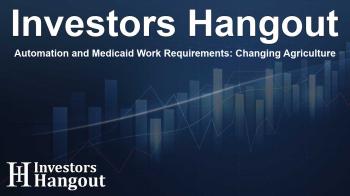Automation and Medicaid Work Requirements: Changing Agriculture

Strategy Shift in the Agricultural Workforce
U.S. Agriculture Secretary Brooke Rollins has made it clear that the future of agriculture may involve significant changes to the workforce. With an increasing reliance on automation and new policies regarding Medicaid recipients, this shift comes as the government aims to address challenges stemming from migration policies and labor shortages.
Emphasizing Automation as a Solution
Rollins stated, "The president has been unequivocal that there will be no amnesty." This sentiment reflects broader political strategies while also highlighting the significant role automation will play in the agricultural sector. The focus is on ensuring that food supply systems remain intact even as borders face tighter regulations.
The Role of Medicaid Recipients
Another key aspect of this strategy is leveraging the Medicaid population as a workforce. According to Rollins, there are millions of able-bodied adults in the Medicaid program who could be utilized effectively. This approach aims to merge support systems with labor needs, ensuring that American workers have opportunities without compromising services.
Long-Term Workforce Vision
Rollins explained the administration's vision for a “100% American workforce,” made possible through automation and strategic workforce integration strategies. This insight is particularly critical as the U.S. grapples with ongoing labor shortages in agricultural sectors.
Farm Security Action Plan
Recently, Rollins unveiled the USDA National Farm Security Action Plan, which focuses on safeguarding both the farmers and the food supply against foreign threats, particularly from hostile nations. By securing agriculture at its core, the government aims to bolster national security as well.
Collaboration Across Partisan Lines
During the announcement, Rollins noted the importance of bipartisan cooperation, emphasizing that the vulnerabilities within agricultural sectors are a concern shared across political lines. “Even the Democrat governors and even the blue states realize what a massive threat this is to national security,” she remarked, underlining a collective responsibility.
Automation and Agriculture's Future
Automation is touted as a primary solution amidst these transitions. Rollins stated, “Ultimately, the answer on this is automation, also some reform within the current governing structure.” By focusing on technology, the industry can maintain productivity while mitigating labor-loss impacts from migration reforms.
Conclusion: A New Direction for the Agricultural Sector
As policy changes evolve, U.S. agriculture stands on the brink of transformation. Automation coupled with thoughtful workforce policies like those involving Medicaid recipients could redefine how farms operate and ensure that labor demands are met despite shifting political landscapes. The coming years will undoubtedly reveal the effects of these strategies in action.
Frequently Asked Questions
What changes are being made to the agricultural workforce?
The workforce is shifting towards automation and utilizing Medicaid recipients to fill labor shortages.
Who is leading the changes in agricultural policy?
The changes are being led by U.S. Agriculture Secretary Brooke Rollins and the current administration.
How does the USDA National Farm Security Action Plan work?
The plan aims to protect U.S. farmland from foreign threats and secure the national food supply.
What are the benefits of automating agricultural processes?
Automation can help maintain productivity while addressing labor shortages and economic challenges.
Will there be cooperation across political lines on these issues?
Yes, the Secretary emphasizes the importance of bipartisan collaboration to address national security threats in agriculture.
About The Author
Contact Evelyn Baker privately here. Or send an email with ATTN: Evelyn Baker as the subject to contact@investorshangout.com.
About Investors Hangout
Investors Hangout is a leading online stock forum for financial discussion and learning, offering a wide range of free tools and resources. It draws in traders of all levels, who exchange market knowledge, investigate trading tactics, and keep an eye on industry developments in real time. Featuring financial articles, stock message boards, quotes, charts, company profiles, and live news updates. Through cooperative learning and a wealth of informational resources, it helps users from novices creating their first portfolios to experts honing their techniques. Join Investors Hangout today: https://investorshangout.com/
The content of this article is based on factual, publicly available information and does not represent legal, financial, or investment advice. Investors Hangout does not offer financial advice, and the author is not a licensed financial advisor. Consult a qualified advisor before making any financial or investment decisions based on this article. This article should not be considered advice to purchase, sell, or hold any securities or other investments. If any of the material provided here is inaccurate, please contact us for corrections.

